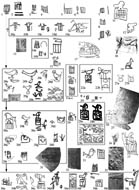|
Part II - DYNASTY 0: THE KINGS
(NAQADA IIIb1,2 - early IIIc1) When W.M.F. Petrie readily
published his excavations in the cemetery B of Abydos, [1] it soon became
clear to him that that some of the piece of evidence he, and E. Amelineau
few years before, had found on that site, did belong to a very ancient
period, one immediately preceeding the First Dynasty Horus Aha and the
legendary Menes (who was then thought to have been buried in the Naqada
"Tomb of Menes" discovered in 1897 by J. de Morgan) [2].
The term 'Dynasty 0', used by James E. Quibell to describe late predynastic
materials he found at Hierakonpolis, was adopted by W.M. Flinders Petrie
for rulers such as Ka-Ip, Ro, Zeser, Nar-Mer and Sma [3]; only more
recently it has gained a general acceptance with its use by W. Kaiser
[4].
 |
The Dynasty 0 rulers of Thinis/Abydos were buried in the
cemetery B; its latest royal tomb was that of Aha (if we exclude Dreyer's
attempt to attribute B40 to Athotis I); Djer started the cemetery commonly
known as Umm el Qa'ab which became the burial place of all the other
kings of the First Dynasty, queen Merneith, and the hundreds of retainers
slain at their burial; after a period of disuse, kings Peribsen and
Khasekhemwy of the late Second Dynasty also built their tombs on this
sacred ground.
Cemetery B, the 'predecessor' of the Umm el Qaab, was in turn the continuation
of an older necropolis, some steps to the north, i.e. the currently
excavated cemetery U.
What had emerged after the work of the archaeologists was not the only
clue suggesting the existence of a "Dynasty 0": Royal Annals,
Turin Canon and later Greek-Latin sources [5], proved as well that many
kings had reigned in Upper and Lower Egypt before the so called 'First
Dynasty'. It must be soon made a precisation: the terms 'Dynasty
0' and 'Dynasty 00' [6], were both cloned to account for newly found
royal names and objects of older and older periods: those just mentioned
found by Petrie and the more recent ones discovered by the German archaeologists
directed by Gunter Dreyer (cfr. below); but the word 'dynasty'
is here somewhat improperly used, because it is often no longer applied
to indicate a same line of rulers of a certain site and of equal origin
(like for the Manetho's dynasties). Dynasty 0 infact, not only
includes the Abydos kings of the B cemetery who preceeded Aha, but also
chiefs from entirely different ruling elites of other sites like Tarkhan
or Hierakonpolis; they have in common only the same chronological collocation
in Kaiser's stufe Naqada IIIb1-2. Similarily the tomb U-j king Scorpion
I and his contemporaries of Naqada IIIa1-2 period, are to be considered
Dynasty 00 kings within the same 'chronological acceptation' of the
term [7]. In this survey on Dynasty 0 I' ll proceed in an inverse
chronological order (but note that no fixed succession has been followed
except for Iry Hor-Ka-Narmer; many of the following kings must have had
contemporary reigns).
The predecessor of Hor Aha was ceratinly the famous NARMER.
Since his discovery, a century ago, almost simultaneously at Hiraconpolis
by Quibell and Green and at Abydos by Petrie, many more attestations of
his name (especially by pottery incised serekhs) have been found in Upper
and Lower Egypt, Western and Eastern Deserts and outside Egypt in Palestine.
Narmer is one of the few single individuals of the Egyptian history
before the Fourth Dynasty on whom whole books might be written; the
role of this sovereign, who can be both considered the last one of Predynastic
and the first one of the Dynastic age, must have been a crucial one
in the development of the early state.
Some uncertainties in his collocation in late Naqada IIIb2 or Naqada
IIIc1, possibly also reflect either a long reign with important cultural
transformations in act, or the fact that this figure fits equally well
at the end of a period as at the beginning of a new one.
The long debated question of the identity of Menes is an argument which
can hardly escape any discussion on such a subject: but it has been until
recently treated by many scholars [8], thus I won't rehearse discussions
already known and available elsewhere, because my aim here is to focus
on the fresh new data and objectives, rather than to face over-speculated
problems.
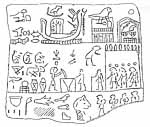 |
Suffice here to underline three points: 1) none of the
'proofs' for the identity of Menes with Narmer or Aha has revealed to
be decisive out of any doubt: the so called 'tomb of Menes' a giant
niched mastaba at Naqada probably built for the king's mother Neithhotep,
produced an ivory label on which the
'Men' sign was below the shrine of the double goddesses, represented
beside the serekh of Aha. The scholars advanced scores of theories on
the meaning of this shrine[9], on the reading of the sign [10], and
on the interpretation of the name Men (Menes) as that of Aha or Aha's
dead father (Narmer) [11].
By the same way Helck's interpretation of the "Prinzenseal"
of Narmer with rows of his serekh beside the men checkboard [12], has
had, with the diffusion of this opinion in some articles of the Lexicon
der Aegyptologie, a certain weight in the equation Aha - Menes. Another
important factor is that Menes was later said to have been the foundator
of Memphis; Narmer is indeed scarcely attested at Saqqara and Helwan
[13], while Aha appears as the first ruler to have had a giant mastaba
(S 3357) in North Saqqara (probably built for his highest official of
the Memphite administration) with impressive funerary offerings [14].
2) I have mentioned [15] the modern interpretations of the Narmer
palette and the fact that the Unification it was once thought to
depict, seems to have happened well before Narmer's reign and lasted
for more than a reign or a generation [16].
3) Despite frequent examples of misinterpretations of early dynastic writings
(espec. kings' names) by later scribes, it is not easy to think that Menes
(Meni in New Kingdom lists) ought to be considered an entirely mythical
figure [17]; leaving aside the latest (and more corrupted) sources we
must admit that the Ramses II period occurrance of Meni in the funerary
king lists (Abydos) and Royal Canon of Turin [18] can't be overlooked,
also given the general correspondence of the other names with Nebty names
attested on Ist Dynasty objects. But this name strangely appears only
with the 18th and 19th dynasty ! Furthermore on the Turin papyrus it directly
follows the Shemsw Hor (which in turn come after the dynasties of gods)
and is written twice: on the first of the two lines with a human determinative,
and on the second one with the god determinative. I continue to prospect
the alternative hypothesis that, whatever the meaning of the 'men' on
the Princes-seals of Narmer and on the Naqada and Abydos Aha label, New
Kingdom scribes or priests might have mistaken archaic documents which
they surely knew or they could have created a mythical figure of the initiator
of the Egyptian human kingship for religious and propaganda purposes,
for the need to estabilish a precise point of departure of their successful
kingship, state, tradition, culture[19]. In 1986 the German expedition re-excavating Umm el Qa'ab
and the cemeteries B and U at Abydos, found an important seal
impression with the Horus names of Narmer, Aha, Djer, Djet, Den and
the king's mother Merneith; some years later a new example, again with
the kings' names and the necropolis god Khentyamentiw was found containing
all the names up to Qa'a, the last Thinite king
of the Ist Dynasty (but now Merneith's was excluded).
On both the clay impressions the oldest king in the list was Narmer:
a clear statement of the light in which he was in the middle and late
First Dynasty! If a Menes did exist, in his quality of initiator of
an epoch, he would have never been preceeded by another individual's
name: thus Aha can't be considered Menes and, even if Aha's reign monuments
at Saqqara, Abydos, Naqada are much more impressive than Narmer's ones,
we can plainly believe that this depends on the fact that Aha enjoyed
the wealthy state which his father (?) handed him down. As I' ve stated
above, Narmer is much more attested in the whole country and abroad
and his reign is marked by an evident evolution in various aspects of
the culture of this growing civilization which appears to owe more to
him than to Aha [20].
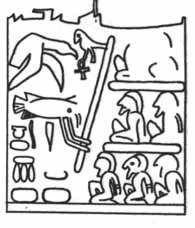 |
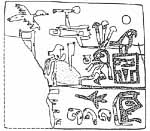 |
Many more objects bearing the name of Narmer are known:
in the Hierakonpolis temple 'Main Deposit', together with the Great
Palette and further older objects, it was also found a small decorated
ivory cylinder with the Nar-fish of his name handing a reed towards three
rows of Libyan prisoners; another well known and widely discussed and
described object is Narmer's Macehead; very
important is also the 1998 finding at Abydos, a label
with the year-event depicting the same military victory as on the palette
and the cited ivory (see n.16 and part I n.2); the recent book of T.A.H.
Wilkinson has a good summary of the sources for this king [21]; however
it doesn't include some pieces which have often been related (indeed without
any sure ground to do it) to Narmer, as the unprovenanced king's
head in University College (he proposes a Second Dynasty date for
it), or the ivory statuette from Abydos in
the British Museum, or, possibly, the limestone stela
fragment from Abydos (U.C. 14278; it might have belonged to Horus
Aha); furthermore Narmer's serekh is on the base of a statue of Baboon,
the god Hedj-Wr, in Berlin [22], and (almost completely erased) on the
thigh of one of the three Coptos Colossi,
the one in Cairo Museum (incisions)
[23]. A 6,5cm diorite male head found in 1898 by F.W. Green at Hierakonpolis, is at Fitzwilliam Museum, Cambridge (E109.1898): there's no trace of it neither in the original publication nor in B. Adams' publication of Green's MS and in the distribution lists (Ancient Hierakonpolis. Supplement, 1974), but it is proposed as 'perhaps representing king Narmer' (thanks to Laura degli Esposti for informing me of this attribution; cf. Fitzwilliam Museum object label and the on-line catalogue). Indeed, considering material and style, it is more likely of 2nd-3rd Dynasty, besides not necessarily a royal portrait.
A stone vessel from Djoser's complex
at Saqqara (note 13) has his serekh incised, some vessels from Abydos
bear his serekh in relief and a couple of cylinder jars from Tarkhan
(?) are inscribed in ink with Narmer's Horus name. It is not sure if Nar(mer)
rather than Scorpion or [Ra]Neb is the inscription in the lower half of
a serekh incised on the left part of the thorax of a statuette (h 11,2cm)
in München St. Samm. ÄK(7149)
(cf. the earlier Oxford -"MacGregor" man [1922.70] and the Third
Dynasty Brooklyn Museum [58192] Onuris statuette).
 |
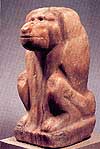 |
As I have said above, Narmer is attested in the Desert
(graffiti around Hierakonpolis, Wadi Qash, Gebel Tjawty, Coptos).
[NOTA: removed passage on Western Desert graffiti].
Yet most of the occurrances of Narmer's name is on jars and jar fragments;
an astonishing number of serekhs has emerged in the last 25 years from
excavations in Israel and Palestine (Tel Erani, Arad, 'En Besor, Halif
Terrace/Nahal Tillah and more) signifying an apex of commercial contacts
between Egypt and Canaan (in comparison, such proofs are less frequent
for the preceeding and following periods).
Some more serekhs have been excavated at Minshat Abu Omar (44.3), Tell
Ibrahim Awad and Tell Fara'in-Buto in the Delta and at Kafr Hassan Dawood
(913) in a c. 1000 tombs cemetery on the southern limit of the Wadi Tumilat.
Dreyer interprets a mark on a jar in a private collection (cfr. n. 22)
as an estate of Narmer in the Eastern Delta.
There is a slight possibility that a Naqada IIIb1 ruler with the name
Nar did exist: a couple of serekhs of this one appear on too early jars
types (cfr. n. 22 and n. 50); but all the other forms 'Nar' do belong
to Narmer. Infact his name often recurs in this abbreviated form with
only the Nar sign; it is unlikely that, as it was hypothesized, the use
of the writing 'Nar' was (always) from the latter part of his reign [24].
Narmer was buried in the sacred necropolis (B) of Abydos, tomb B17/18
(two united rectangular mudbrick-lined chambers; tot. length c. 10m x
3,00-3,10 large and 2,50-2,80 deep); it is few meters north of the westernmost
chamber (B10) of his follower Aha (Kaiser-Dreyer, M.D.A.I.K. 38, 1982,
220-221).  Some
meters to the north of Narmer's, a true double chamber tomb B9/7
(these two are circa 1,80 meters distant; B9 is c. 5,9 x 3,1m; B7 is c.
6 x 3,2 m; both are c. 1,9m deep), produced inscriptional material of
his predecessor: his name, KA, also appears in at least
two different writing forms: with the standard 'ka' sign and with the
same sign but upset; because this latter can also have a different reading,
i.e. the verb 'to embrace', P. Kaplony proposed (1958) to read the name
Sekhen. More than 40 inscriptions have been found in Ka's burial
chamber (B7, the southern of the two) of the Abydos tomb: one is a seal
impression, all the remaining ones are inscribed on tall jars or cylinder
vessels (incised or written in black ink). Some
meters to the north of Narmer's, a true double chamber tomb B9/7
(these two are circa 1,80 meters distant; B9 is c. 5,9 x 3,1m; B7 is c.
6 x 3,2 m; both are c. 1,9m deep), produced inscriptional material of
his predecessor: his name, KA, also appears in at least
two different writing forms: with the standard 'ka' sign and with the
same sign but upset; because this latter can also have a different reading,
i.e. the verb 'to embrace', P. Kaplony proposed (1958) to read the name
Sekhen. More than 40 inscriptions have been found in Ka's burial
chamber (B7, the southern of the two) of the Abydos tomb: one is a seal
impression, all the remaining ones are inscribed on tall jars or cylinder
vessels (incised or written in black ink).

|
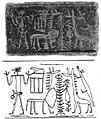
|
 |
Apart from this site, the only further attestation of Ka
in Upper Egypt is a carbon inscription on a jar fragment recently found
at Adaima (N. Grimal in B.I.F.A.O. 99, 1999 p. 451 fig.1; more inscriptions
in van den Brink, Archéo-Nil 11, 2001 in print).
Other traces of Ka have been found in northern sites: in the cemetery
A of Tarkhan an ink inscribed cylinder vessel from tomb 261, and in Helwan
tombs 1627 H2 and 1651 H2 two tall jars with incised inscriptions; a couple
of inscribed vessels fragments are unprovenanced.
A new serekh has been found on pottery by F. Hassan in tomb 1008 at Kafr
Hassan Dawood, at the southern boundary of the Wadi Tumilat (Hassan in
E.A. 16, 2000, 37-9), and another one is known from a pottery fragment
from Tell Ibrahim Awad (van den Brink, The Nile Delta... p. 52 fig. 8.2).
Finally there is a cylinder seal from Helwan 160.H3 with an anonymous
serekh and a human figure beside it; this has his arms raised and the
right hand appears to be partly placed in the serekh, just nearby to where
the name would be written; A.J. Serrano has thus proposed that this figure
could designate the king and his royal name -Horus Ka- contemporarily
[25].
The serekh is probably anonymous and of slightly earlier date than Ka's
reign, as Dr. C. Koehler believes.
The stratigraphic analysis at cemetery B seems to confirm
that Ka immediately preceeded Narmer; indeed there are some inconsistenies:
an important tall jar type which has been used before and after Ka's
reign, has never been found during his own.
A recent useful innovation in the study of this period has been achieved
by E.C.M. van den Brink [26]: he has produced a catalog of 24 complete
jars with incised serekhs of Naqada IIIb-c1. The interest of this work
is in that, contrarily to two older corpora provided by W. Kaiser in
1964 and 1982, van den Brink's has been prepared giving much more than
a superficial consideration to the pottery types on which the serekhs
are incised. The analysis of the pottery types has resulted in a distribution
of the serekhs within four main phases corresponding to the development
of the jars types; this comparative study has succeeded in fixing a
more certain chronological frame for some royal names of Naqada IIIb;
although few minor problems do arise [27] this system has offered a
valuable means of relative datation of these names and it has even avoided
the weak points inherent to Kaiser's subdivision into three 'Horizonten'. 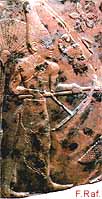 Before
continuing to ascend the Abydene line of Dynasty 0 we must consider two
rulers who have left no trace of themselves at Abydos; King SCORPION
(II) and Horus Crocodile. Both are known by very few inscribed
objects. Before
continuing to ascend the Abydene line of Dynasty 0 we must consider two
rulers who have left no trace of themselves at Abydos; King SCORPION
(II) and Horus Crocodile. Both are known by very few inscribed
objects.
The particularity of these rulers is that the epigraphy, provenance and
typology of their sources speaks for a datation surely not post-Narmer
and very likely neither pre- Ka. They might be thought to represent 'Gegenkonigen'
(as Dreyer defines Crocodile) thus rebels or usurpers; more likely they
were the last expressions of ancient local indipendent ruling lineages
which ceased to reign only when the powerful kings of the Thinite region
moved northward to occupy the territiries with which, until then, they
had only entertained peaceful commercial relations; but in this respect
the position of Scorpion II at Hierakonpolis is harder to explain and
Dreyer thinks this was a Thinite king too. The different writing of his
name and the Nekhen finds can't be a certain indication of the Hierakonpolite
origin of Scorpion II: Iry Hor had a different royal name mark too, and
Narmer was also known at Nekhen.
The giant macehead of Scorpion from Hierakonpolis
(it's bigger than Narmer's) is another important masterpiece of the period;
for this reason (as well as for its being virtually the only object surely
attributable to this king, for the debates on the ritual it depicts and
for some further motives) this macehead is of public domain in the field
of divulgative Egyptology; there is no need to add a detailed description;
I only remark that the name of this king is not written in the serekh
and is not surmounted by Horus; the expression for 'sovereign' is rendered
by the 'Rosette' [28]; Cialowicz thinks that at the right end of the rows
of Rekhyt-bows standards and dancers in the upper registers, there would
be the standing king Scorpion represented (in higher scale) with the red
crown of Lower Egypt (cfr. Adams - Cialowicz, Protodynastic Egypt, 1997
fig.1).
Another macehead from the same cachette
at Hierakonpolis, far more fragmentary than the already fragmentary previous
one, shows a king sitting under a canopy; he wears the red crown and the
Heb Sed robe; Arkell interpreted a slightly visible sign before the head
as a Scorpion [29]; Adams has found no trace of the rosette in a break
in front of the red crown curl; therefore the object could belong to another
king of the period immediately before Narmer (or Narmer's own): I would
suggest that the fragmentary glyph might be interpreted as a standard
with a crocodile whose tail hangs down (Horus Crocodile ?).
Cialowicz has given a convincing interpretation of the scene as the Sed
celebration after a military victory of Scorpion (or Narmer); to the right
of the sitting king, in the centre of the scene, there is a big falcon
(turned towards the king) holding in the claws a rope which directs to
the right-end of the preserved fragment; here, behind and in a lower position
than the falcon, there must be a number of prisoners (one ear is clearly
visible) which the rope kept during their presentation to the king by
Horus.
The last reluctantly accepted piece of evidence for king Scorpion II is
a graffito in Upper Nubia, Gebel Sheikh Suleiman [30].
It is not far from the notorious graffito now in Khartoum Museum: it represents
a scorpion with a prisoner into its claws; two more human figures with
a bow and false tails, are directed towards the captive and the scorpion.
This scene could, in my opinion, be far earlier than the presumed time
of Scorpion II: it's surely related to a chief, but I would prefer a date
in Naqada IIIa (Scorpion I?) or even late Naqada II.
The date is far more certain for an alabaster vessel from Quibell and
Green's Hierakonpolis excavations: but the scorpions and bows which surround
its body can't be attached with full confidence to king Scorpion; a larger
group of objects which would be assigned to this king's reign has been
proposed by Kaplony [31]: but it can't be assumed that almost any known
late predynastic representation of scorpions ought to refer to the king
in object.
The tomb of Scorpion II has never been found; Dreyer and Hoffman have
speculatively proposed respectively the 4- chambers Abydos B50 and the
Hierakonpolis loc. 6 tomb 1 [32]. Therefore the slight traces of Scorpion
II hinder any safe reconstruction about the place of origin of this obscure
sovereign and his role in the late predynastic history.
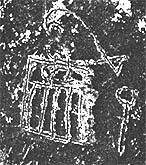 |
A royal name within a falcon topped serekh incised on a
jar from tomb 160.1 at Minshat Abu Omar has been alternatively read as
Aha and Scorpion. The sign does look like a scorpion, curved with both
the tail (which is drawn above the body) and the head looking rightward,
whereas the falcon looks towards the left.  Van
den Brink has proposed that this sign might be an upset variant of the
coil identified by Dreyer on two vessels and a seal impression from Tarkhan
(cfr. below) [33]. Van
den Brink has proposed that this sign might be an upset variant of the
coil identified by Dreyer on two vessels and a seal impression from Tarkhan
(cfr. below) [33].
The two ink-inscribed cylinder vessels
were found by Petrie [34] in tombs 1549 and 315.
 |
Kaiser and Kaplony read their serekhs name as Scorpion (with
the tail now curved below the animal); but this is impossible because
the scorpion would have on both the examples an opposite orientation than
the falcon above the serekh; Dreyer [35] has introduced, to account for
these two serekhs (but not the M.A.O. one), a king CROCODILE,
ruler of the Tarkhan region; he also advanced that to this king might
belong the apparently anonymous serekh (? cf. n. 36) (surmounted by a
bull's head and surrounded by crocodiles) on a seal
impression also found by Petrie at Tarkhan (tomb 414, Narmer's reign)[36].
Contrarily to Kaiser and Kaplony, Dreyer (thanks to new infrared photos)
doesn't see only one sign in the ink serekhs, but a crocodile (in profile)
above a coil of rope (cfr. note 39).
I must now make a remark: the M.A.O. 160.1 has much more distinction
between a squarish body and a slender linear tail, but I suggest that
a crocodile would not be depicted, even in a cursive and stilized writing,
as an animal with two very distinct parts of the body (cfr hieroglyphs
of other animals as bees, scarabs, birds), because it has a uniform
shape from his head to almost all the tail length; so this is surely
not a crocodile. The sign looks more like a scorpion (this must not
necessarily mean that it belongs to king Scorpion II of Hierakonpolis,
it might also be another omonymous sovereign). The alternative proposed
by van den Brink is also interesting (note 33) becuse he thinks that
the only coil is here represented, thus (Crocodile) The Subduer (snj.w).
The crocodile is generally depicted in profile (with straight or curved
tail) not to be confused with the lizard [37]; the scorpion sign here
is identical with the Gardiner's sign G
54 ('fear') which is used in Saqqara king list and Turin Canon as
a later variant of the mid Second Dynasty king's name Sened.
This makes what we have assumed to be the scorpion tail become the head
of a goose; and this is the only way to account for the animal to look
towards the opposite direction than Horus (unless considering it as
an unlikely kind of political statement against the other Horus kings
of the country), because the sign 'snd' is always written with the body
in accordance to the writing direction and the curved snout and face
in the opposite direction (cfr the Saqqara King list and Turin Canon).
Therefore the two vessels in Tarkhan t. 315 and 1549 could not name
Scorpion (II) but a Naqada IIIb2 king whose name can be read Horus Sened,
The Dreadful [38] or (if two signs are involved as Dreyer has hypothesized)
Crocodile the Subduer [39].
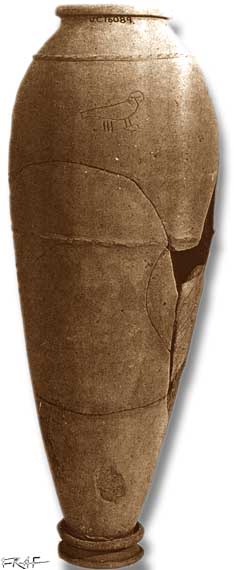 |
The oldest king known from Abydos necropolis B is IRY
HOR. His name was read 'Ro' by Petrie but the identification as
a royal name was considered doubtful because the falcon is directly placed
on the mouth sign and it never appears in a serekh; only since an article
of Barta (G.M. 53, 1982 p. 11-13) and the publication of the second DAIK
(re)excavations campaign at Umm el Qaab his status and reading as king
'Iry Hor' has been almost universally accepted; Wilkinson has advanced
this could be a treasury mark; Kaplony read it, since 1963, as a private
name Wr-Ra (thus interpreting the bird as a wr swallow) [40].
Many jar fragments from the chamber B1 (c. 6 x 3,5) of his double tomb
(B1/2) were incised with this name; the German
equipe excavation of B2 (m. 4,3 x 2,45) produced another incised jar fragment
plus eight ink inscriptions and a private seal impression, vessels fragments
with the name of Narmer and Ka and parts of a bed, in particular a fine
ivory fragment of bull-leg bed-foot. An offering pit B0 is immediately
south of B2.
Two seal impressions with rows of Hor+mouth (no register line) are known:
one from Abydos B1 and another from debris of tombs Z86-89 at Zawiyet
el Aryan [41]; this latter is the only signal of the presence of Iry Hor
outside of Abydos necropolis, if we exclude a further uncertain incision
on a spindle whorl from Hierakonpolis [42].
Few meters north of Iry Hor's B 0/1/2 there are 3 tombs (X, Y, Z) which
link the B cemetery with the more ancient cemetery U; some of its latest
tombs (U-j, U-k, U-s, U-f, U-g, U-h, U-i, U-t and the cited U-x, U-y,
U-z datable to Naqada IIIa2-b1) prosecute towards the past the history
of the Abydos chiefs; they will be analyzed in a further study ("Dynasty
00"). We leave now definitively Abydos to consider royal names
from other cemeteries. Note that (contra Kaiser, Dreyer, van den Brink
and partly T. Wilkinson) Stan Hendrickx doubts that all the serekhs I
am going to consider from early Naqada B actually do represent royal names
(G.M. 2001 in print).
 |
Three pear-headed mace signs form the name of another king
whose serekhs were found at Turah [43]; these have both three circles
below the serekh and no falcon atop it. These signs substitute the palace
facade device in the serekh, and only a narrow empty space (where the
name is usually written) is left in the upper part. But a variant of the
same name was found somewhere in the Eastern Delta, with the palace facade
lines, the three maces in the name compartment and a further mace out
of the serekh (which this time has the falcon on it) [44]. All the three
inscriptions were incised on (completely preserved typ.74j) jars which
belong to van den Brink's IIIrd phase/type [45], roughly spanning Naqada
IIIb2 (Kaiser's Horizon B), therefore the same period as the reigns of
Iry Hor, Ka, early Narmer, Crocodile and Scorpion.
 Interestingly
van den Brink has associated this rulers' name with the sign Gardiner
M8 (sha) and with Helck's reading 'Wash' of the name of the prisoner Narmer
smites on the verso of his palette [46]. If the writing showed instead
tree maces the reading would be Hedjw / HEDJW-HOR. Interestingly
van den Brink has associated this rulers' name with the sign Gardiner
M8 (sha) and with Helck's reading 'Wash' of the name of the prisoner Narmer
smites on the verso of his palette [46]. If the writing showed instead
tree maces the reading would be Hedjw / HEDJW-HOR.  Two
more serekhs from Turah are dated in v. den Brink phase/typology IIb (Kaiser,
1982 Horizont A) or Naqada IIIb1 [47]; the serekhs have only an horizontal
line in the name-space, so, despite the lack of the falcon, they' re usually
read NY-HOR. Two
more serekhs from Turah are dated in v. den Brink phase/typology IIb (Kaiser,
1982 Horizont A) or Naqada IIIb1 [47]; the serekhs have only an horizontal
line in the name-space, so, despite the lack of the falcon, they' re usually
read NY-HOR.
Sometimes they have been read as a variant of Narmer's name [48]: a serekh
of this latter (?) from Ezbet el-Tell [49] has the Nar sign represented
just as an horizontal stroke. Another serekh has been always considered
to be of Narmer: it was found by Petrie in Tarkhan tomb 1100; the (complete)
jar inscription has the Nar fish inside the serekh (no falcon upon) and
a kind of mer-hoe below it; Helck supposed this sign was an alternative
to the mer chisel for the second part of the king's name; but probably
the hieroglyph is Gardiner sign U13-14 (shen'a, deposit). The problem
with this vessel arises by its form typology (74b), which is v.d.Brink
type IIb: too early for Narmer's reign; indeed the horizontal hieroglyph
is here not a simple stroke but it closely resembles the body of the Nar-fish
[50].
 HAT-HOR
is the reading of a serekh on a jar
from Tarkhan tomb 1702 (as for Nj-Hor this serekh is falconless too, so
the reading could be simply Hat or Haty [51]); the name sign would be
probably associated with Nar(mer) too if the jar on which it is incised
(type 74b) wasn't of too early a type for Narmer's reign which is Naqada
IIIb2-c1. HAT-HOR
is the reading of a serekh on a jar
from Tarkhan tomb 1702 (as for Nj-Hor this serekh is falconless too, so
the reading could be simply Hat or Haty [51]); the name sign would be
probably associated with Nar(mer) too if the jar on which it is incised
(type 74b) wasn't of too early a type for Narmer's reign which is Naqada
IIIb2-c1. The earliest serekhs of Naqada IIIb1 (van den Brink type
IIa) are, alike the oldest of those emerged from the necropolis U
at Abydos (IIIa2) [52], anonymous and without falcon atop of them.
The only exception is provided by five known attestations of an anonymous
serekh surmounted by two falcons facing each other.
 |
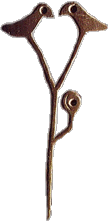 |
Generally indicated as Double Falcon this
king name was encountered by M.J. Cledat; in the spring of 1910 he was
excavating at El Mehemdiah, in north-eastern Delta, when a bedawin arrived
to his camp with a jar and some fragments incised with inscriptions which
Cledat soon recognized as archaic; their provenance was a site few miles
distant, known as El-Beda, where they had been found during the planting
of a palm-grove. Led to that place Cledat found more fragments in the
debris, but, when he returned once again in the following year he only
gathered few flints [53]. In his publication he reported three serekhs
with the double falcon and another one with only a strange mark on its
right (see below and n.56).
In 1912 it had already been published the excavation in Turah by Junker;
in a tomb at Ezbet Luthy (SS) [54] some years before, a complete jar with
the Double-falcon serekh had been found.
The fifth inscription of Double Falcon is on a jar from Sinai [55]; all
the 5 incised serekhs have a mark on the right (but the Turah on the left).
Dreyer (M.D.A.I.K. 55, 1999, 1ff) thinks the upper part of two of the
serekhs from el-Beda represents a 'dw' related to the royal name Double-Falcon
(he considers dw as a variant of the three-mounts sign khaset)
which might have influenced later concave-top serekhs.
The last known Double-Falcon serekh fragment has been found at Tell Ibrahim
Awad (van den Brink, Nile Delta p.52 fig. 8.1).
More inscriptions of Double Falcon will be published by van den Brink
in Archéo-Nil 11, 2001 in print.
A relief on a slate palette in Geneva
shows a standard (?) with two falcons facing each other; beside it there
is the curly-tail dog which is also found on the Brooklyn Museum Knife
handle from Abu Zeidan tomb 32 (early Naqada III, cfr. Needler, 1984),
on the Pitt-Rivers comb, and on the Gebel Arak and Gebel Tarif knife-handles
(see their pictures below, in the Conclusions).  Anonymous
serekhs are being somewhat frequently found in Delta, Upper and Lower
Egypt, but also in Southern Palestine. Anonymous
serekhs are being somewhat frequently found in Delta, Upper and Lower
Egypt, but also in Southern Palestine.
One of the fragments Cledat found at El-Beda had and incised serekh (without
name-compartment) with a strange mark on its right: it could perhaps represent
a name, Ka(?)-Neith [56].
Two complete jars with serekh have been found at Rafiah, Southern Palestine
[57], one on a v.d. Brink type IIa and another on a type I jar; type I
corresponds with late stufe IIIa2 / early IIIb1 to which two more examples
are added by van den Brink: they are anonymous serekhs on two jars from
tombs 1021 and 1144 at Abusir el Meleq [58].
Early Naqada IIIb1 are the Abydos tombs U-s (119) and U-t (120) which
yielded some ink anonymous serekhs
[59]. The study of these inscriptions provide important informations
about the oldest forms of writing and their use: this always concerns
the royal propaganda and the royal administration.
They can give interesting clues about the regional authority of the
rulers and the range of their commercial - exploitative activities.
Indeed it is very difficult trying to trace the area of influence of
many of these local chiefs basing on few inscriptions only. The problem
is that all the rulers attested in Naqada IIIB (= b1-2), with the exception
of the Thinite line Iry Hor-Narmer, have not been documented by royal
tombs of their own but only from inscriptions found in their dignitaries'
tombs, in desert graffiti or on some unprovenanced objects. In this
respect it is noteworthy the material excavated in urban or cultual
areas as those reached by the German at Tell Fara'in Buto where serekhs
have been found too. Ancient royal inscriptions reported in the desert sites
can be a valid suggestion not only to know the paths to some resources
but also to understand possible directions of commercial or 'colonial'
interest (as the discussed case of the Wadi Qash and Djebel Tjawty or
those in Nubia).
During the 1910-11 archaeological survey of Nubia, C.M. Firth found at
Sayala in a disturbed tomb (n.1 of cemetery 137) a gold mace-handle (now
lost) decorated with embossed motives representing rows of animals, a
typical late Naqada theme often found on ivories, bones, combs and knife-handles
[60]. This object was probably imported from Upper Egypt; the chiefs of
the Seyala polity controlled the entrance to the Wadi Allaqi (rich in
gold mines) and a part of the trade circuit between Egypt and Upper Nubia.
Some of the graves in cemetery 137 had sandstone slabs as a roof and the
mentioned tomb 1 also contained two Egyptian palettes, two stone vessels,
two mace heads (each one with gold handle) and other status-marking objects;
thus Seyala must have been an important trade center which, as possibly
the whole A-Group and the much later C-group culture, benefited of the
role of mediation in the complex net of interexchange of products between
Upper Nubia and Upper Egypt and beyond; near Seyala there were found rock
drawings with reprsentations of boats in the peculiar style of Naqada
IIc-d.
 |
Some 150 km upriver from Seyala there is the site of Qustul;
some materials from older excavations have been published by B. Williams;
they show clear traces of Egyptian influence. The most important tomb
of the cemetery (L) was L24, in which a stone decorated fragment from
an incense burner revealed an astonishing representation of a boat procession
towards a palace facade building; the first boat carries a prisoner held
onto a seat by another individual; the central boat carries the king,
sitting and equipped with long robe, flail and white crown; he faces towards
the last boat as the falcon on the serekh which is just in front of his
head followed by a 9 slender petals rosette; before the last boat an arpoon,
a rampant antelope and a man and, below the prow of the last boat a kind
of saw-fish saw (cfr. those on Coptos Colossi) and a big fish. The last
boat is occupied by a wild animal (halfway between bull and lion) followed
by a falcon (?) topped standard [61]. Another incense burner was found
in tomb L11(below).
Such a evidence, even not lacking chronological problems, was interpreted
by the excavator as a proof for a possible Nubian A-group influence on
the Egyptian state formation! Now that excavations in the cemetery U at
Abydos have brought to the light a series of early Naqada III royal tombs
(the 12-chambers U-j is contemporary or earlier than Qustul L24) this
theory needs no alternative discussions to be disproved (but indeed K.
Seele and B. Williams proposed an early Naqada IIIa datation for the "Archaic
Horus" burner from L11, the Qustul burner
of L24 and the emergence of the Nubian monarchy -cfr. B. Williams, op.cit.
1986, 1987).
Some of the paintings on vessels from the tombs of Qustul have motifs
related to the late Naqada II- early Naqada III Egyptian iconography,
especially the bowls from tombs L19 and L23 (see figure below); this parallels
the similarities between the A-group incense burners (but also seals -cf.
below- and the Sayala mace-handle)
and the Upper Egyptian decorated ivories.
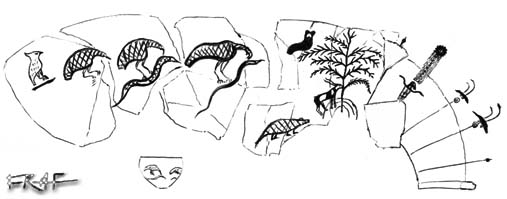
Cross-comparisons of ceramic types (in the richest tombs there was also
pottery imported from Upper Egypt and Palestine) lead us to prefer a later
Naqada IIIb1-2 date for the emergence and apex of this Ta-Seti state into
the A-Group culture.
Initial A-Group coincides with Naqada I, terminal A-Group with Early Dynastic
period; military raids and the more frequent presence of Ist Dynasty rulers
in Nubia likely aimed to obtain a direct control of the products trades
with the lucrative markets of the far south (felines pelts, elephant tusks,
gold, resins, timber, apes and other exotic genders); therefore when Egypt
was capable to bypass or to abolish the costly intermediation of A-group
centers, this culture rapidly declined, and certainly the military intervention
of Egypt accelerated its complete extinction.
Another tomb (L2) at Qustul contained, among some objects,
a cylinder jar (net-painted decoration) and, above all, a storage jar
[62] inscribed with a falcon on a squarish
sign; it has been read PE-HOR. This possible royal-name
was incised, unlike most of the serekhs on jars, post - firing; in these
circumstances, as van den Brink notices [63], the clay can't consent easy
round scratches as when it's wet, but, like in rock graffiti, it forces
the engraver to produce mostly squarish signs. T. Wilkinson [64] states
that the inscription may merely represent a ownership mark.
 This
latter author recalled the attention on two
rock graffiti (which he never coupled with the one from Qustul) [65]
whose serekh contained, just below the falcon, a sign he reads P (althogh
in one of the two inscriptions it has more rounded horizontal sides);
even harder to interpret is the lower sign, which rests with some vertical
strokes one the base of the serekh and has a rounded upper part; Wilkinson
proposes it could be 'spt' (Gardiner D24) or more likely 'khent' (Q3)
comparing it with similar signs in Den's domain 'Hor Sekhenty Dw' on seal
impressions [66]. But almost certainly this is not a 'khent', which would
be drawn with the vertical signs partly overlapping and surpassing the
upper horizontal curve. I would propose two alternatives: the lower sign
could be either the one of serekh panelling or the profile of an animal
with tail and snout bent close to the ground[67]. Infact G. Dreyer (Umm
el-Qaab I, 1998 p. 179) reads it P + Elephant. This
latter author recalled the attention on two
rock graffiti (which he never coupled with the one from Qustul) [65]
whose serekh contained, just below the falcon, a sign he reads P (althogh
in one of the two inscriptions it has more rounded horizontal sides);
even harder to interpret is the lower sign, which rests with some vertical
strokes one the base of the serekh and has a rounded upper part; Wilkinson
proposes it could be 'spt' (Gardiner D24) or more likely 'khent' (Q3)
comparing it with similar signs in Den's domain 'Hor Sekhenty Dw' on seal
impressions [66]. But almost certainly this is not a 'khent', which would
be drawn with the vertical signs partly overlapping and surpassing the
upper horizontal curve. I would propose two alternatives: the lower sign
could be either the one of serekh panelling or the profile of an animal
with tail and snout bent close to the ground[67]. Infact G. Dreyer (Umm
el-Qaab I, 1998 p. 179) reads it P + Elephant.
 |
The first evidence to suggest the possibility of a Nubian
(A-Group) proto-state 'Ta-Seti' during early Naqada III was a seal
impression from Siali, found in 1960 by K. Seele. It represents a
sitting, bearded, bare, ruler (?) apparently saluting with his hand the
Ta-Seti glyphs (Land of bows). There are also a falcon atop a niched building
(in Kaplony this seems an ensete tree; note the differences in the interpretation
of the impression by Williams and Kaplony), an anonymous falcon-topped
serekh (maybe two) (near the head of the sitting man) and some hounds
(or monkeys). Over the nestled rectangles-palace with falcon there are
two "D-Pylons" (?) and seven circles with a projection from
their upper part; finally, alike on the Qustul burner and on the Metropolitan
Museum knife-handle, there is a crescent and also the strange wavy band
(false tail ? Cfr. below).
Since long before this latter finding, a seal from Faras (near Qustul)
was known displaying the same kind of Palace Facade (Williams, J.N.E.S.
46, 24; I.A.F.S. fig. 884, no falcon).

 The
southernmost attestation of a possibly Dynasty 0 serekh is that at Gebel
Sheikh Suleiman, near Wadi Halfa and Buhen (IInd cataract, 50 Km south
of Qustul). This graffito (now in Khartoum Museum) had been interpreted
as reporting a military raid of king Djer, early First Dynasty [68]. W.
Helck expressed first doubts about the reading as Djer, proposing the
serekh ought to have been an anonymous one [69]. This was further developed
after a new analysis by Murnane [70] showing that the 'djer' sign was
a deeper and later antelope facing left. Despite the now widely accepted
datation to the Dynasty 0 (Naqada IIIb1) I wouldn't exclude a priori (on
the basis of the iconography and falcon/ serekh/ cities signs) a possible
lower date up to the IInd dynasty [71]. The
southernmost attestation of a possibly Dynasty 0 serekh is that at Gebel
Sheikh Suleiman, near Wadi Halfa and Buhen (IInd cataract, 50 Km south
of Qustul). This graffito (now in Khartoum Museum) had been interpreted
as reporting a military raid of king Djer, early First Dynasty [68]. W.
Helck expressed first doubts about the reading as Djer, proposing the
serekh ought to have been an anonymous one [69]. This was further developed
after a new analysis by Murnane [70] showing that the 'djer' sign was
a deeper and later antelope facing left. Despite the now widely accepted
datation to the Dynasty 0 (Naqada IIIb1) I wouldn't exclude a priori (on
the basis of the iconography and falcon/ serekh/ cities signs) a possible
lower date up to the IInd dynasty [71].
Three jar ink inscriptions from Tarkhan must now be reviewed:
they are two serekhs from tombs 415 (S.D. 80 cemetery A) and 300 (S.D.
80 cem. L?) and a possible private name from 412 (S.D. 78, cem. A) [72].
Tomb 415 serekh has been equated to Narmer (cfr. n. 24); a long beaked
falcon surmounts the serekh from t. 300; two roughly circular signs
in the name frame are possibly remains of Aha's name [73].
The oldest of the three inscriptions (s.d. 78) with no-serekh, was read
as the private name Djehwty Mer by Petrie; it has been considered a
royal name by Kaiser, while Dreyer [74] compares the bird with the falcon
of the previously dealt serekh attributed to Aha. Therefore the two
surely royal names among these three jar ink inscriprions should be
dated to Naqada IIIc1.
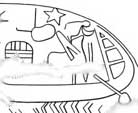 |
Two among the most important decorated objects of Dynasty
0 are now in Metropolitan Museum of Art, New York.
We have already considered the unfrequent device called 'Rosette' appearing
as a mark of royalty near the name of Scorpion II and the Qustul incense
burner ruler into a boat (and as a title of Narmer's official or priest
on the Narmer Palette).
The rosette also accompaigns a possible serekh (?) and other erased
signs (crescent) which appear nearby another white crown king on the
right hand of the the Metropolitan Museum
knife handle recto [75]. As on the Qustul object this ivory handle
represents a boats procession. The king with flail sits in an high prow/stern
boat facing and paddling towards a standard which has two crescents
atop of it (throwing sticks?); from the pole of the standard a rope
appears to catch four heads before which there is the same 'enemy head
+ papyri' sign surmounted by Horus on Narmer palette verso, 3 papyri
and undecipherable signs. Below this row three canonical boats probably
land by a Per-nw (Per nsr) shrine; the last boat on the right carries
a bearded man with his arm raised (hand in front of his face); this
man is thus depicted just below the king; behind his head there's a
kind of thick wavy band (similar to that at the waist of the man standing
before the Bull's boat on the Qustul incense burner) which could be
part of the boat stern (the following boat has a lotus-bloom like sign
on the stern, not beside it).
The verso of the knife handle shows two rows of men turned towards a mat-work
and niches shrine (Per Wr?) apparently surrounded by water; there's a
man kneeling behind the shrine and the lower row is made of seven kneeling
men (squatting with one knee raised, a typical pose of the prisoners)
preceeded by the walking king with white crown. Of the upper row remain
five partly visible bearded men holding in the left hands a kind of crook
resting on the left shoulder and, in the right hand, the bent and incised
handle of a throwing stick. The space between the two rows behind the
king's head is completely defaced.
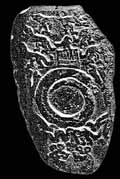 |
The other object is the Metropolitan
Museum decorated palette [76] . It is decorated on one side only and
shows the typical scenes with animals and monsters within a frame provided
by the two rampant canids (Lycaons) forming the unpreserved edge of the
palette. Above a coiled snake, which forms the usual circle for grinding
powder, there is a falcon topped anonymous serekh: it is low in height
and its internal seems to be entirely fulfilled by the palace facade device;
Fischer has suggested this sign to be very similar to that on the Narmer
(?) stela fragment from Abydos [77]; it slightly resembles 'men' and 'djer'
hieroglyphs too.
It's not the place for a detailed discussion of the palette and its probable
chronological position relatively to the other palettes.
We must here only underline the importance of the serekh which indicates
that other more developed palettes must have been late Dynasty 0 productions
and many of them (as the Bull, Tehenw, Battlefield palettes) certainly
even contained, in their lost portions, the royal names of some of the
Dynasty 0 kings we have reviewed here [78]. Despite the recent occurrance
of a decorated palette at Minshat Ezzat
in a middle First Dynasty context (with tools with Den's serekh) this
latter palette must have been a two centuries old ceremonial object for
that time and all these palettes do remain chronologically linked with
the period Naqada IIIa1/2-b1/2 (Hendrickx's A1/2-B) [79]. The possible royal names Dreyer proposes to read on the
Coptos Colossi and on some seal impressions, tags and vessels inscriptions
from Abydos cemetery U, will be considered in the page of Dynasty
00/Naqada (IIc-d2/) IIIa1-2.
For some more Dynasty 0 royal names which have been published after this
page was finished (or which I have known later) see the Table
of Royal Names [*Nj-Neith, *Hwt-Hor (?) and the Adaima
serekh (Horus Ka ?)]. CONCLUSIONS
The Naqada IIIB 'culture' can now be analyzed through a considerable
number of found-types: pottery and stone vessels, decorated- palettes,
-knife handles and -ivories, other gravegoods, desert graffiti, tombs.
But this apparently densely populated scenario is instead somewhat hard
to be satisfactorily figured out.
One of the major lacunae is the lack of known royal cemeteries other
than the Abydos B and Qustul L necropolis.
Despite the good picture we are depicting of Hierakonpolis (espec. loc.
6 and 29A) and the data from the Memphis/Fayyum area and Delta, no other
royal tomb has ever been located of Naqada IIIb1,2 period. Serekhs continue
to emerge from private tombs (*), but it is very hard to reconstruct
the history of Late Predynastic Egypt without other 'precious pieces'
of this complex puzzle. Delta sites as Tell Fara'in-Buto and Tell Farkha
are noteworthy for their urban - templar contexts.
 |
Artifacts like the knife handles of Gebel Tarif, Gebel el
Arak, Carnarvon, University College (see figure) and Brooklyn Museum,
or the Metropolitan Museum Davis comb and others, are known since long
time (see them all here) [80];
the same goes for the corpus of Ceremonial Slate
Palettes; they demonstrate the existence of a still partially obscure
world of 'visual metaphors' pertaining to the ideology and to the 'artistical'
expression of well formed leading minds.
Another ivory knife handle, very similar to the one from Gebel Arak, has
been found in tomb U-503 (see below) at Abydos, dating Naqada IId2. And
the german excavators of the cemetery U have also published some late
Naqada I vessels which provide us the earliest attestation of motives
common to the later royal iconography [81]. This was already 'announced'
too by well known representations like the Hierakonpolis
tomb 100 paintings, the Gebelein cloth,
the Naqada jar-fragment red crown and more [82]. Therefore the process
of origin and evolution of the most ancient proto-state(s) must be investigated
since a period which is very distant from the time of "Menes",
and which involves the need to fill up many gaps (cfr. below).
Of course the prime mover of our deeper knowledge and
understanding of this 'historical' periods and its products lies always
beneath the ground: like for the deciphering of unknown scripts (or
for the interpretation of forgotten languages) the principal aid comes
from the variety of sources. The more documents we have, the
easier our task.
But I have likewise expressed above (part I) the need for multidisciplinary
approaches to practical and theorical questions: in other words it's
important to try to see our objectives from different points of view
(not only art history, philology, archaeology, but also palaeobotany,
geology, anthropology, semiothic, sociology, history of religions, statistics,
ethnology and others) like indeed it's happening in these last decades
[83]. The problem of the reliefs carved on palettes and knife-handles,
apart from the meaning of their symbolism, is that nearly all of them
are unprovenanced, thus without an archaeological contest which may indicate
their datation. Only the Abu Zeidan t. 32 knife handle and few more had
a precise chronological collocation.
The mentioned German excavation at Abydos have produced some additional
important evidence which can be useful to set these categories of objects
into a better defined chronological framework: in part III I' ll try to
elaborate a sequence of the known palettes and knife handles, starting
from these objects as the Knife handle from Abydos U-503
or the fragments from tomb U-127;
both tombs date Naqada IId; I would suggest that such a date, earlier
than Abu Zeidan knife handle in Brooklyn (Early Naqada III in W. Needler,
1984), suggests that the reliefs with rows of animals were contemporary,
not earlier, than those with human figures and boats. Alternatively the
Brooklyn ivory handle would have been already c. two centuries old an
object when it was buried in tomb 32 (other implications of the datation
of U-127 handle, will be dealt with below in pt. III).
Therefore the first need is always that for newer and newer archaeological
campaigns.
Related to this aspect is the necessity for an equal consideratrion of
the territory: until recently the Delta was a big question mark many scholars
didn't hesitate to define "a closed book". Kaiser, Bietak, Wildung,
Von der Way, van den Brink, Kroeper and many others have contributed to
open that book...
Now it is the Middle Egypt, between Badari and Gerzah, the least known
part of the Nile valley [84].
There is a number of further question marks like the Mesopoltamian influences,
the writing in Naqada IIIa1,2, the meaning of some enigmatical representations,
the relative and absolute order of ceremonial palettes, knife-handles,
maceheads, pottery types, the horizontal stratigraphy of whole cemeteries,
foreign commercial contacts, chronological problems and correlations with
Near Eastern phases, stages and modalities of the successful expansion
of the Naqada culture and the state formation. After this introduction on the footprints of the Dynasty
0 rulers, I am going to consider, in part III, some specifical problems
concerning their world.
It's difficult to understand a culture only by means of some of its aspects;
we have no transparent documentation of the political, social, economical
and religious systems of the earliest state. Only few clues which must
be carefully analyzed and interpretated.
Some of the hypothesis we actually do accept might be disappointed in
the future. It's still a long way to go: the main point is that we are
already walking it.
________________ Notes of Part II
[1] Petrie, Royal tombs pt. I, 1900, id., Royal Tombs pt. II, 1901,
id., Abydos pt. I, 1902; For general discussions of the period see J.
Vandier, Manuel d' Archaeologie Egyptienne I, 1952; J. Hayes, The Sceptre
of Egypt, 1953; B. Trigger in Trigger, Kemp, O' Connor, Lloyd eds., The
Rise of Egyptian ..., 1-70, 1983; W. Helck, Untersuchungen zur Thinitenzeit,1987
(esp. p. 90-99); T.A.H. Wilkinson, State Formation in Egypt, 1996; id.,
Early Dynastic Egypt, 1999, esp. 47-59; id. M.D.A.I.K. 56, 2000; Jimenez
Serrano, Los Reyes del Predinàstico Tardìo (Naqada III),
in: BAEDE 10, 2000, 33-52; K. Cialowicz, La Dynastie 0, conquerants ou
administrateurs ?, in Studies in Ancient Art and Civilization, n. 7, 1995
p. 7-23; id., La Naissance ... , 2001; S. Hendrickx, Arguments for an
Upper Egyptian Origin of the Palace-Facade and the Serekh during Late
Predynastic - Early Dynastic times, G.M. forthcoming 2001 (I must thank
Stan Hendrickx for sending me this article).
Petrie was undoubtly the first Egyptologist to think and work in a modern
scientific way; he excavated sites from all the periods of Egyptian history,
but his greatest contribute was that in the Perdynastic and Early Dynastic.
He always used to quickly publish his excavations (although he was often
forced to make selections of his findings for limits of budget and costs);
his researches had not as a main aim the 'hunt for Museum pieces' (he
openly criticized Amelineau's "methods") but in his view a sherd
could have the same value as a statue. He was not only a forerunner in
the fieldwork, but also in theoretical approach: despite the lack, at
that time, of methods of absolute datation, Petrie had invented an ingenious
system of relative chronology (Sequence Dating) based on seriations of
archaeological contexts (tombs) through their founds (mostly gravegoods
which he previously arranged in a relative order basing on the development
of their shapes, decorations and other attributes). This method allowed
him to have a sufficiently precise idea of the datation (into 50 seq.dat.
stages) of any tomb(-type) he excavated which produced a good number of
pottery types or other classes of seriated objects. Petire's published
excavations and corpora of predynastic pottery (nine classes and more
than 700 types), protodynastic pottery and slate palettes continue to
be of fundamental importance for the modern pre- and proto-dynastic studies.
His subdivision of the predynastic into three 'cultures', Amratian [S.D.
30-37 (mod. shift. 30/31 - 37/39)], Gerzean [S.D. 38-60 (38/40 - 52/62)]
and Semainean [S.D. 60-75/76 (54/62 - 76/79)], was later refined and correlated
with the Early Dynastic period, forming the basis of the successive chronologies
(Kaiser's 'stufen'; cfr. W. Needler, Predynastic and Archaic Objects...,
1984, 44: NAQADA I = S.D. 30-38; NAQADA IIa,b = S.D. 38- 40/45; NAQADA
IIc,d = S.D. 40/45 - 63; NAQADA III = S.D. 63-80; for further adjustments
see Kaiser, M.D.A.I.K. 46, 1990 and especially S. Hendrickx, in A.J. Spencer
ed., Aspects of Early Egypt, 1996 p. 36-69).
[2] Petrie equated Aha with 'Menes' which, in later traditions, is the
name given to the foundator of Memphis and of the 'First Dynasty'. Petrie
was one of the first scholars, with J. Garstang, to challenge the ownership
of the Naqada mastaba to Menes. For a recent re-analysis of this tomb
and its founds cfr. Kahl et al., M.D.A.I.K. 57, 2001 (in print) and id.,
Vergraben, verbrannt, verkannt und vergessen. Funde aus dem "Menesgrab",
Munster 2001 (my most sincere thanks to J. Kahl for presenting me this
publication).
[3] Zeser and Sma revealed not to be royal names at all; 'Ip' is not part
of Ka's name but an indication of U.Eg. product.
I have been unable to ascertain the absolute first use of the name "Dynasty
0"; Petrie uses it in Diospolis Parva, 1901, 24, (and in his divulgative
'History of Egypt' 7th ed., 1912, but I think already in its 5th edition,
1902 and I don't know if in the older editions too). In Hierakonpolis
part I, 1900, J. E. Quibell describes some predynastic objects as 'Dynasty
0', thus it must be Quibell or Petrie to first adopt this term around
1899. (I am indebted to J. Kahl and E.C.M.van den Brink for their suggestions
on this and other matters; but obviously eventual mistakes are only mine).
[4] M.D.A.I.K. 41, 1985, p. 71.
[5] As Herodotus, Manetho, Diodorus Siculus, Plinius the Elder; for the
Shemsu Hor, the names on Annals line 1, and Annals reconstructions cfr.
pt. I passim and notes 5-7; also cfr. Kaiser, Z.A.S. 84, 1959 p. 119-32;
id., Z.A.S. 91, 1964 p. 86ff; W. Helck, Untersuchungen zu Manetho...,
1956; id., Untersuchungen zur Thinitenzeit, 1987.
[6] 'Dynasty 00' has been introduced by E. van den Brink, The Nile Delta
in Transition, 1992, vi n.1, but it hasn't been as widely used as 'Dynasty
0'. He states that Dynasty 00, 0 and 1 respectively coincide with the
periods Naqada IIIa, b and c.
[7]cfr. prev. n.; also note that T. Wilkinson, Early Dynastic Egypt, 1999
p. 52 tends to include in the Dynasty 00 meaning, also the anonymous "owners
of the Abydos vessel [U-502, U-239], the tombs in Naqada cemetery T, the
Hierakonpolis painted tomb (100) and the Gebelein painted cloth",
therefore all evidence of high status, likely local chiefs, which do belong
to the previous period, Naqada II and, above all, to different regions-stocks.
See Wilkinson op. cit. 53, 61 for the term 'Dynasty 0'.
As noticed above (n. 3) J.E. Quibell, in Hierakonpolis I, 1900, already
applied the definition "Dyn. 0" to his book plates with late
predynastic materials, thus in a clear chronological not 'genealogical'
sense.
[8] W.S. Smith, Two Archaic Egyptian Sculptures, B.M.F.A. 65, 1967, 70-84;
D. Wildung, Die Rolle Agyptischer Konige ..., 1969, 4ff; S. Morentz, Z.A.S.
99, 1972 pref.; Helck, op. cit. 1987 passim; id., Lexicon Ag.; J.P. Allen,
G.M. 126, 1992 p. 19ff; M. Baud, Archéo-Nil 9, 1999, 109ff; ; P.
O' Mara, D.E. 46, 2000 p. 49ff; id., G.M. 182, 2001 p. 97ff. For a good
general summary of the discussion cfr. J. Kinnaer, Narmer or Aha. Who
was Menes ? KMT forthcoming issue, 2001 (I disagree with this author on
few minor points only); see also n.11.
[9] W. Spiegelberg, O.L.Z. 4, 1900; V. Vikentiev, A.S.A.E. 33, 1933 (double
throne); B. Grdseloff, A.S.A.E. 44, 1944 p. 279ff; S. Schott, Hieroglyphen
1950.
[10] The new fragmentof this label found in Aha's tomb central chamber
(B15) at Abydos (M.D.A.I.K. 38, 1982 pl. 57c) leaves out any doubt that
the sign is really the men checkboard hieroglyph (Gardiner sign Y5).
[11] Cfr. arguments for Menes in W.B. Emery, Archaic Egypt, 1961, 33-7;
J.P. Lauer, Histoire Monumentale ... 1962, 19ff; I.E.S. Edwards, The Early
Dynastic Period in Egypt, C.A.H. IIIed. I.1, 1-70, 1971.
[12 ] Helck, ZDMG 103 (=28 n.s.), 1953 and id. et al, in L.A.
[13 ] Saqqara: serekh on stone vessel found in the Step Pyramid gallery
7 (B) (Cairo Mus. J.d.E. 88406), Lacau -Lauer Pyr. Deg. IV.1, p. 9 pl.
1.1; ibid. IV.2 p. 1-2; Abydos: Petrie, R.T. I pl. 4.2; id. R.T. II pl.
2.3,6; Helwan: serekh on a fayence tag in the debris near tombs 1H3 and
40H3.
[14]W.B. Emery, Hor aha, 1939; circa 800 cylinder vessels with ink inscriptions
of Aha were found, but also stone vessels, labels, long pottery horns
of rhinoceros.
Isolated serekhs of Aha from other memphite cemeteries have been found
on cylinder jars at Helwan, Zawiyet el Aryan (Z1), Abu Rawash (402).
[15] cfr. part I passim and n.1 and 2.
[16] I want to shortly express here my view on the matter of the period
of political Unification; it has been argued since Kaiser's foundamental
researches (part I n. 12) that this must have happened some generations
before Narmer; indeed, although we have seen that a cultural uniformity
was achieved as early as Naqada IId2-IIIa on the whole Egypt, it is equally
true that up to the very end of the predynastic period few local and indipendent
royal lines did exist at Tarkhan, Tura, Hierakonpolis and probably elsewhere;
the relationship of these ones with the Thinite rulers whose successors
form the Ist Dynasty is obscure. But the mere attestation of mysterious
and yet undefined figures like Scorpion II and Crocodile (also cfr. text
below) may indicate that only with Narmer's reign the last local polities
had been finally and definitively abolished (in a peaceful or violent
way).
Important clues in this question are the already discussed (part I, esp.
n. 2) Narmer's label year-event, mentioning the same defeat as the palette'
s, the abrupt disappearance of the 'dualistic motives' (like the two monsters
on the palette's recto) just with the end of his reign, and, finally,
the apparent contemporaneity of his reign with that of his rival (?) of
Hierakonpolis, Scorpion II (indipendently of how did Narmer ruled
him out).
Therefore, even if I agree that the process of political superimposition
or subjugation of the southerners over the north did last for generations
and did begin before Narmer, it seems to me very likely that this latter
king might have had still an outstanding part in this play.
[17] A mythical Sesostris, mixing the characters of more than one XIIth
dynasty kings, is known from the Greek sources; the name Menes could be
interpreted as well as conflation of two or more archaic kings.
[18] D.B. Redford, King-lists, Annals and Day-Books ..., 1986; for the
Shemsw-Hor cfr Kaiser, Z.A.S. 84, 119 ff; id., Z.A.S. 85, 118 ff; Helck,
ArOr, 18, 120ff; von Beckerath M.D.A.I.K. 14, 1ff.
[19] H. Fischer pointed out two more possible men-like occurrances (Artibus
Asiae 21, 1958): the palace facade device on the serekhs on a stela
fragment (UC14278) found by Petrie at Abydos (nearby Narmer and Aha
tombs) and that on the Metropolitan Museum palette (anonymous serekh)
are very apt to be confused with the sign men (also some graphies
of the sign djer can and have been mistaken with the serekhs palace
facade).
Schott, po.cit., 1950, proposed to read "Ma-nu" the Lion + nw-vessel
name in a fortress of the Bull palette, Louvre E 11255.
[20] See T. Wilkinson op. cit, 1999 p. 68 for the Menes-Narmer debate
and p. 71 for the change in the commercial relation with Near East during
Aha's reign.
[21] op.cit.1999, p. 68,69,70 (Zawiyet el Aryan, Tura, Helwan, Naqada);
for a complete list of all the inscriptions of Narmer known up to 1993
cfr. J. Kahl, Das System der Agyptischen Hieroglyphenschrift der Dynastie
0. - 3., quellen 79-131; my website http://members.xoom.it/francescoraf/
has an updated list in the Dynasty 0 page.
[22] Berlin Mus. 22607, h. cm. 52; cfr. also E. Schott, R.d.E. 21, 1969
p. 77ff.; and M.D.A.I.K. 50, 1994, 224ff.
The limestone stela fragment with serekh device (niches and a 'men-like'
top) is in Petrie, Abydos I, 1902 pl. 13; Fischer, Artibus Asiae 21, 1958
fig. 24; id., J.A.R.C.E. 2, 1963 pl. VIb.
Other mostly unprovenanced inscriptions on jars and stone vessels are
found in Kaplony I.A.F.S. fig. 1061-2; id. K.B.I.A.F. 1138; id. Steingefasse
5; id. Klein Beitrage... pl. 6,7,18,19 (= id. M.D.A.I.K. 20, n. 1-3).
An alabaster plate fragment M.D.A.I.K. 46, 1993 p. 38 fig.5; an ink inscription
on cylinder vessel M.D.A.I.K. 54, 140, fig.30; a (type 74b !) jar incised
serekh Dreyer interprets as a eastern Delta estate of Narmer in M.D.A.I.K.
55, 1999, 1ff.
[23] B. Williams, J.A.R.C.E. 25, 1988 p. 35-59; in fig. 1, p.26 there
are also three further incisions: a Nar fish, a serekh and an harpoon.
(Also cfr. G. Dreyer, S.D.A.I.K. 28, 1995 and id. Umm el Qaab I, 1998;
B. Kemp, C.A.J. 10, 2000, 211-242).
[24] In the important tomb Tarkhan 414 a third form, Narmer-Tjay, appeared
on one of the seal impressions of Narmer found in it: cfr. Petrie et al.
Tarkhan I, 1913 pl. 2,2 (also cfr below and n. 36); V. Vikentiev (J.E.A.
17, 1931, 67-79) proposed to read his name 'Nar Ba Tjay', whereas Godron
advanced the reading 'MeryNar' (A.S.A.E. 49, 1949, 217-20, pl. 1 with
24 examples, + note compl.). The Nar sign in the abbreviated form varies
from a simple horizontal stroke to a wider sign (where the fish head and
tail are easily distinguishable) as the R.O.M. example G.M. 180, 2001,
67ff.
Another very doubtful attestation of Narmer is a ink inscription on a
jar from Tarkhan tomb 415 (Petrie et al. op.cit. 1913, pl. 31.69) cfr.
below.
[25] The seal was found by Z. Saad; recently reconsidered by C. Kohler
(G.M. 168, 1999 p. 49ff) and by A. Jimenez Serrano (G.M. 180, 2001 p.
81ff).
For the tomb of Ka and more findings from within and nearby it cfr. M.D.A.I.K.
38, 1982 p. 221ff, 229-30; fig. 14 and 15; Petrie, Abydos I pl. 1, 2,
3; id., R.T. I pl. 13.89 (seal impr.) and 13.90; Gilroy, G.M. 180, 2001
fig. 2, pl. Ib (Royal Ontario Museum unpublished fragmentary serekh).
About the Helwan jars: note that Z. Saad (S.A.S.A.E. 3, 1947 p.111) states
that the provenance of these jars is inverted than that shown in the number
written on his plate 60 (where 1627H2 is written below the right hand
jar with inverted ka; I think I can also read 1651H2 at the right end
of the label placed below the left hand jar); I have followed the plate
60 indication as did Kaiser 1964 and contrarily to Kaiser 1982 and van
den Brink 1996.
[26] In A.J. Spencer ed. 'Aspects of Early Egypt', 1996 p. 140-158; E.
van den Brink has kindly informed me that the second part of his study
(Incised Serekhs on pottery fragments) is going to be published in Archéo-Nil
11, 2001.
[27] For example the serekh with the Nar fish from Tarkhan 1100 has too
early a position to be Narmer's as the epigraphy would suggest; the serekh
22, of king Iry Hor (B1), is later than those of Ka and than some of Narmer
too; of course these strange behaviours can't depend on van den Brink's
method of tracing and subdividing the pottery types development: instead
it's possible that there are external factors to be reconsidered, as the
duration of some pottery types which might have to be stretched out.
[28] E. Baumgartel proposed that there was no need to distinct this king
from Narmer; in the same way Horus Ka had been already interpreted to
be possibly an indication that B9/7 was the tomb of Narmer's ka (but this
is impossible for the finding of a seal impression in B7 and other reasons).
Cfr. H.S. Smith in Adams - Friedman eds. 'The Followers of Horus', 1992,
244ff for the semantic value of the Rosette; but also T. Schneider in
S.AK. 24, 1997 p. 241ff. For other Rosettes cfr. below (Qustul incense
burner and MMA knife handle) but note that some more appear on Gebel
Tarif, Carnarvon, Univ.
College and Brooklyn Museum knife handles, Metropolitan Mus. comb).
[29] In Antiquity 37, 1963; see also B. Adams, Ancient Hierakonpolis,
1974, p.3, pl. 1, 2; K.Cialowicz, Le Tetes de Massues..., 1987 p. 41-3
fig. 5. The Macehead is in Universoty College, London inv. 14898. For
another macehead in UC (inv. 14898 A) the 'Bearers Macehead' cfr. Quibell
'Hierakonpolis' I (1900) pl. XXVIA and Cialowicz op. cit.
[30] Published by W. Needler in J.A.R.C.E. 6, 1967, p. 87-91 pl. 1 and
2.
[31] i.e. the incision on the Abu Umuri palette and others: Orientalia
34, 1965, p. 132ff, pl. 19-23; id., I.A.F. I, II passim
[32] Dreyer in M.D.A.I.K. 43, 1987; id., M.D.A.I.K. 46, 1990 p. 71; Hoffman,
The Sciences, Jan/Feb 1988, 40-7.
[33] Wildung, Aegypten vor den Pyramiden, 1981 fig. 32; van den Brink
op. cit. pl. 28 a,b: Horus (Crocodile -Sbk or Hmz-) the Subduer (cfr.
id. op. cit. 1996 and 2001 in preparation); only B. Adams has attempted
the equation of this serekh with Horus Crocodile; for Dreyer cfr. n. 35.
A. Jimenez-Serrano (BAEDE 10, 2000) points to Scorpion II. In my opinion
this serekh must be compared with those of Horus Ka, especially the falcon
of the serekh incised on the jar from Helwan tomb 1627 H2 (also associated
with the mace sign) and the inverted ka sign of that from Helwan t. 1651
H2; alternatively the MAO serekh could name Hor Aha or even quite a different
unattested sovereign. See this table
n. 29, 30a, 30b.
[34] T. 1549: Petrie, Tarkhan II, 1914, 11 and pl. 9.3; t. 315: Petrie
et al. 1913, 9, 29, pl. 31.66 (wrongly reproduced as Ka) and pl. 60 (no
mention of the vessel here); cfr. Kaplony I.A.F. III pl. 1, 2; id. I.A.F.
II, 1090.
[35] G. Dreyer in Adams - Friedman eds. op. cit. 1992, p. 259ff.; also
cfr. n. 39.
[36] cfr. n. 24; Tarkhan 414 (S.D. 78) contained some seal impressions
of Narmer and a wine jar (type 76b) of his too; for Dreyer cfr. notes
35, 39. My friend Andreasson Leif notes that the crocodile on standard,
with a feather on the head, is the later emblem of U.E. nome VI (Dendera);
as I state above there was, before Naqada II, a strong polity between
the Thinite and Ombite regions (Hu, Abadiya, Dendera). I would also add
that the bull-head on the serekh of the seal recalls the Hathor cow heads
on Narmer palette. John D. Degreef kindly points out to me that the central
element of the seal is not a serekh at all, but it must be the representation
of the temple of Sobek at Crocodilopolis, an opinion which I fully agree
with.
[37] Gardiner signs i3-i5; Moller, Hieratische Palaographie I, 1927 sign
n. 239, 241; 'snd' is n. 226. See IInd Dynasty ink drawing and glyph of
a crocodile in Lacau-Lauer, La Pyramide à Degrées V, 1961 n. 247 and 18*.
[38] The presently known oldest attestations of the goose hieroglyph date
to the Old Kingdom (Unas P.T.). But in the Second Dynasty offering lists
on Helwan stelae (with 'pictographical use' but drawn alike the later
hieroglyph G54) at least two examples are shown in Z. Saad, Ceiling Stelae
(C.A.S.A.E. 21), 1957 pl. 13 and espec. 24 (1641 H9).
W. Helck, Untersuchungen zur Thinitenzeit, 1987 p. 92, states about the
goose-like sign that "an die snd-Gans ist wohl kaum zu denken!".
[39] Dreyer, loc.cit., proposes the reading of the (Gardiner V1, V7) curls
on one of the seal impr. from Tarkhan 414 and on the two mentioned Tarkhan
vessels (below the crocodile) as Sheny or Shendet, recalling the Fayyum
old name Shedet; but also the reading I ve proposed of the ink inscriptions
Sened recalls She(n)ed(t),and this could have been an efficacious word-
pun for a king of the Fayyum region (see also n. 36).
Note that Dreyer's op.cit, 1992 fig. 1b presents a clear spot on the crocodile's
head, like a kind of eye: but owing to the brush size and to similar spots
which must be traces of the ink deterioration (see fig. 1a and 2a) this
can't by no means indicate the animals' eye; finally I rehearse that the
attributive 'The Subduer' for the reading of the rope coil has been proposed
by van den Brink (op. cit. 1996, 2001 cfr. n. 33) whom I thank for some
informations and corrections.
[40] Barta' s (loc. cit. in the text) reading followed by Kaiser-Dreyer
(M.D.A.I.K. 38, 1982, 232ff) has been questioned by Wilkinson in J.E.A.
79, 1993 p. 91-3; see also Petrie, Abydos I, p. 4. For Wr-Ra cfr. Kaplony,
I.A.F. I, 1963, 468 (Personal names index).
[41] Kaplony, I.A.F. I, 62, 66, 467-8; I.A.F. III fig. 13; Zawiyet el
Aryan: Dunham, Zawiyet ..., 1978 pl. 16B.
[42] Quibell- Green, Hierakonpolis I, 1900 pl. 63.1; this is attributed
by Kaplony to Wr-Ra, and inserted in J. Kahl 's S.A.H, 1994 quelle n.
5 (Iry Hor).
Note that van den Brink has proposed to read Iry Hor the post-firing scratch
on a storage jar from Qustul L2 and two desert graffiti actually considered
a distinct royal name, Pe-Hor (cfr. n. 63 , 67 and text below).
For the evidence on Iry Hor and the whole 'Dynasty 0' also see Jimenez
Serrano, op. cit. in n. 1 (pt. II).
[43] By Junker (1912) in tombs 15g2 and 17L7a.
[44] H.G. Fischer, J.A.R.C.E. 2, 1963 (part 8), p. 44; fig. 1, pl. 6a,
6c. Other drawings in T. Wilkinson, op.cit. 1999 fig. 2.3.3; Helck, op.cit.
1987, 93 i; photos in van den Brink, op.cit. 1996 pl. 30a; although considering
the difficulty to draw precise small circles, it's relatively easy to
do this when the clay is still wet, before firing the jar; a careful look
at the drawings and photos procures me at least a light doubt that the
name on this jar in the Metropolitan Museum might not be formed by three
identical signs and none of these might be an hedj mace. The serekh on
Fischer published jar might indeed represent a different ruler than the
one attested on the two Tura jars.
[45] Op. cit. 1996, 140ff and tab. 5
[46] Van den Brink, op.cit. 1996 p. 147; for the reading Wash and other
textual considerations on Dynasty 0 kings: Helck op. cit. 1987 p. 90-99.
[47] Junker, 1912, tombs 19g1 and 16g9, both incised on completely preserved
jars of Petrie' s (Protodynastic Corpus, 1953) type 75s.
[48] As T. Wilkinson, op. cit. 1996 p. 13 indicates.
[49] Van den Brink, op.cit., 1996 number 21; it has a falcon on serekh,
the name variant Nar, and a circle with central point (as the later sign
Ra or day). The two Nj-Hor jars of n. 47 are in van den Brink, op.cit.
1996 nos. 8 and 7 respectiv., fig. 25 b-d.
[50] Petrie, Tarkhan II, 1914 pl. 6 and 30; Kaiser-Dreyer, M.D.A.I.K.
38, 1982 fig. 14.39; van den Brink, op.cit., 1996 n.10; the same problematic
affects Narmer' s (?) jar in M.D.A.I.K. 55, 1999, 1ff (n.22).
[51] Petrie, Tarkhan II, 1914 pl. 6 and 30; Kaiser-Dreyer, M.D.A.I.K.
38, 1982, 264ff ('Hat Hor' reading) fig. 14.6 ; van den Brink, op. cit.,
1996 n. 9.
[52] Pumpenmeier, in Dreyer et al. M.D.A.I.K. 49, 1993, 39-49; Dreyer
in Umm el Qaab I, 1998.
[53] M.J. Clédat, A.S.A.E. 13, 1914, 115-121, fig. 3-6, pl. 13.
[54] South of the southern cemetery; Junker, Tura, 1912, 1, 31, 46ff,
fig. 57.5; van den Brink, op. cit., 1996 n. 6.
[55] Oren, Sinai, 184 fig. 37; Kaiser-Dreyer, M.D.A.I.K. 38, 1982 marke
5.
[56] Cledat, op. cit. 1914 fig. 5; Kaiser-Dreyer, M.D.A.I.K. 38, 1982
marke 12.
[57] Cfr. ref. in Kaiser-Dreyer, M.D.A.I.K. 38, 1982, 268 fig. 16.1, 16.2;
van den Brink, op. cit., 1996 n. 3 and 4.
[58] Van den Brink, op. cit., 1996 n. 1 and 2; Kaiser-Dreyer, M.D.A.I.K.
38, 1982 marken 9 and 19 (inverted references in fig. 15).
[59] U-s: Dreyer et al., MDAIK 46, 59 fig. 3a,b; U-t: Dreyer et al., MDAIK
49, fig. 9; Dreyer, M.D.A.I.K. 55, 1999, 1ff.
I must rehearse that, although the oldest known serekhs are (ink) inscribed
in Naqada IIIa2 tomb U-j vessels and incised or painted on early Naqada
IIIB jars, the lack of name (compartment) can't be taken as an early-dating
proof per-se: some anonymous serekhs (potmarks of royal ownership ?) are
found on Ist dynasty jars, as those from Abu Rawash t. 402 or Abydos B15
(Aha' reign).
[60] See H. Whitehouse in Friedman-Adams eds. op.cit., 1992, p. 80-1 fig.
3.
[61] Williams - Logan, J.A.R.C.E. 46, 1987, 245ff.
[62] B. Williams, Excavations between Abu Simbel ...Part I: The A-Group
Royal Cemetery at Qustul, 1986, 147-50, pl. 76-7 (the jar is reg. 24168).
[63] Personal communication; also the opinion that this inscr. and the
graffiti might represent Iry Hor has been expressed to me by this author.
[64] T. Wilkinson, op.cit. 1999 p. 54.
[65] T. Wilkinson, J.E.A. 81, 1995 p. 205-210 fig. 1a, 1b (= Winckler,
Rock Drawings I pl. 11.2, 11.3 from Site 34 in Armant Western Desert)
[66] Kaplony, I.A.F. III, fig. 218, 227
[67] Van den Brink has informed me that these graffiti may perhaps represent
Iry Hor too: as in the Qustul jar, incised post firing, the scratches
hardly yield fine round signs; indeed Iry Hor is always written without
any serekh and one of the two P (?) is perfectly square. A. Jimenez Serrano
interestingly proposes [Los Reyes del Predinàstico Tardìo
(Naqada III), in: BAEDE 10, 2000, 38] that the lower sign might be the
hieroglyph for gold (nub) reading: Hor hwt nwb (Horus, lord of
the house of gold).
[68] Sayce, P.S.B.A. 32, 1910, 262ff; Arkell, J.E.A. 36, 1950 p. 28-9,
fig. 1, pl. 10; I. Hoffmann, BiOr, 28, 1971, 308-9.
[69] Helck, M.D.A.I.K. 26, 1970, 85.
[70] J.N.E.S. 46, 1987, 282-5; ibid., 263-4 (Williams-Logan date the serekh
to Kaiser's Horizon A 'the period of incense burners and seals from Nubia'.
[71] Arkell, op.cit. 1950, already pointed out the similar representation
of dead enemies' corpses on Khasekhem(wy) statue beses (but this motif
is indeed roughly unchanged in Eg. reliefs and incisions' -cfr. some late
Naqada IIIb decorated palettes-).
[72] Petrie et al. op.cit., 1913 pl. 31.69, 31.70, 31.71 respectively.
[73] But note that the ink inscr. in ibid. 31.66 (Crocodile/ Scorpion)
had been drawn in the plate as a kind of upset ka. See Dreyer loc. cit.
in note 74.
[74] Kaiser in Dreyer-Kaiser, op.cit. 1982 p. 262,267 (fig. 15 n. gg);
Dreyer in Friedman - Adams op. cit. 1992 p. 261 n.9.
[75] Number 26.241.1; it was gifted (with its flint) to the M.M.A. by
Howard Carter; the decoration is very poorly preserved; provenance unknown;
cfr. Williams - Logan, op.cit. 1987, 245ff, fig. 1-7; the rosette has
indeed the shape of a 5 pointed star, while that from Nubia has 9 slight
petals.
[76] Hayes, Scepter of Egypt, 1953 p. 28-9, fig. 22; H.G. Fischer, Artibus
Asiae 21, 1958, p. 82 ff, n.34, fig. 19,20; H. Asselberghs, Chaos en Beheersing.
Documenten uit Aeneolithisch Egypte, 1961, fig. 170.
[77] Fischer, loc.cit.; cfr. above notes 19, 22.
[78] Another important general consideration on these palettes has since
long ago involved the seemingly Delta provenance of most of them.
[79] For the Minshat Ezzat palette see: S.G. el Baghdadi: La Palette decorée
de Minshat Ezzat ... una palette decorée en contexte archaeologique, Archéo-Nil
9, 1999.
[80] For these objects see Vandier op.cit. 1952; Asselberghs, op.cit.
1961; Benedite, J.E.A. 5, 1918, 1ff, 225ff; Cialowicz, in Friedman - Adams
eds. op.cit. 1992 p. 247-258.
[81] New ivory knife-handle: M.D.A.I.K. 54, 1996 p. 99 fig. 7, pl. 5;
Two Late Naqada I interesting vessels: ibid. pl. 6; also cfr. T. Wilkinson,
op.cit. 2000.
[82] The Mid-Late Naqada II and Naqada IIIa1,2 will be the object of another
study.
[83] Egyptology has been often criticized in the past for its markedly
conservative character. It has remained for long time a basically phylological
discipline, because of the overwhelming importance the writing and texts
had in the '800; the predynastic studies are in this sense a world apart,
because only archaeological fieldwork can explain writingless cultures.
More than twenty years ago Egyptology has begun to be more open to other
disciplines and this has had a positive effect of regeneration: K. Butzer,
Early Hydraulic Civilization, 1976; K. Weeks ed., Egyptology and the Social
Science, 1979; M. Hoffman, Egypt before the Pharaohos, 1979; Trigger,
Kemp, O' Connor, Lloyd, Ancient Egypt. A social History, 1983; B. Kemp,
Ancient Egypt, Anatomy of a Civilization, 1989; these are all examples
of the new vitality of Egyptological studies through innovative minds
and inspired thoughts which have heavily influenced present generations
of scholars.
It's also very important the increased variety of countries which now
play an active part in the excavations: not only France, Germany, United
States and England but also the same Egypt, Italy, Spain, Australia and
especially Poland.
[84] Cfr. Bard, J.F.A. 21.3, 1994, 265-288; id., J.A.R.C.E. 24, 1987,
81-93; C. Kohler, G.M. 147, 1995.
This page is part of two articles I have submitted for
a paper and for a University concourse.
The author is preparing a degree thesis on the Second Dynasty at the I.U.O.
Napoli; he has also created the website EARLY DYNASTIC EGYPT on the Internet
at http://members.xoom.it/francescoraf/ © FRANCESCO RAFFAELE 2000-2001 |
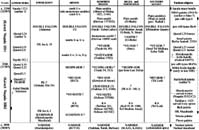
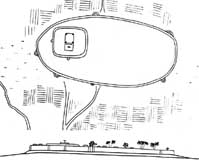











 Van
den Brink has proposed that this sign might be an upset variant of the
coil identified by Dreyer on two vessels and a seal impression from Tarkhan
(cfr. below) [33].
Van
den Brink has proposed that this sign might be an upset variant of the
coil identified by Dreyer on two vessels and a seal impression from Tarkhan
(cfr. below) [33]. 


 Anonymous
serekhs are being somewhat frequently found in Delta, Upper and Lower
Egypt, but also in Southern Palestine.
Anonymous
serekhs are being somewhat frequently found in Delta, Upper and Lower
Egypt, but also in Southern Palestine.





